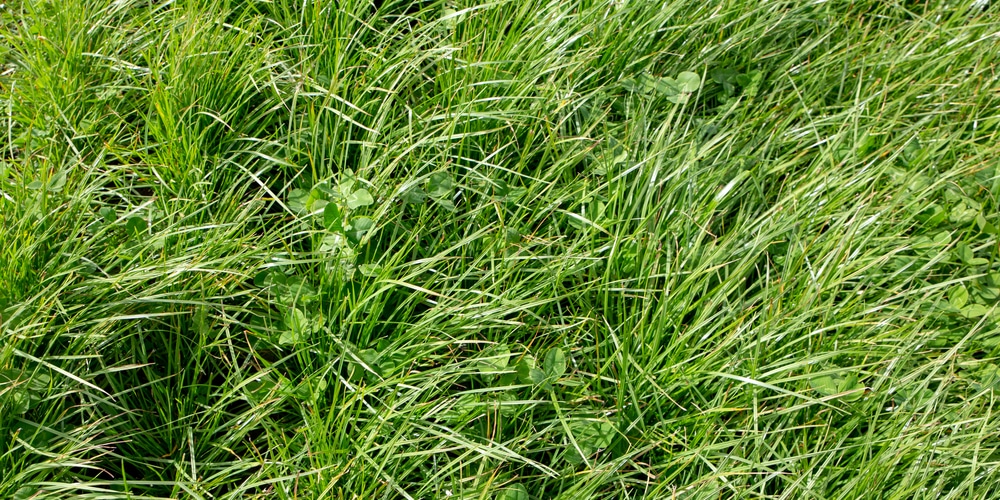If you live in a cooler climate and are looking for cool-season grass, you may be wondering whether to plant tall fescue or perennial ryegrass. These grasses are both excellent if you live in a climate with colder winters and cooler summers.
Both perennial ryegrass and tall fescue are very similar. They are both intolerant to frost but thrive in milder climates. They produce bunch-like clumps and are hardy varieties that can withstand lots of traffic. There are also some differences between these types of grasses, so many gardeners are wondering which to choose. Let’s look at perennial ryegrass vs. tall fescue.
Perennial Ryegrass Versus Tall Fescue
Tall fescue and perennial ryegrass look different. If you examine the blades of tall fescue, you’ll see that they are broad and flat. They are a dark green color, shiny on the underside, and have visible veins and serrated edges. When fully established, tall fescue has a deep root system, and the grass is dense.
Perennial ryegrass has a more delicate texture, and the blades are lighter green. Ryegrass also looks shiny on one side and has serrated tips to the blades.
Uses
Tall fescue was initially used as pasture grass to feed horses and cattle as it produces high-quality fodder. It’s very hardwearing and can cope with high traffic volumes, making it great for sports fields or schools’ playgrounds. Tall fescue is also great for home lawns, especially if you have children and pets running around.
Perennial ryegrass can also withstand heavy traffic and is commonly used on golf courses, sports fields, school playing fields, and lawns. It’s a fast-growing variety of grass that is hard-wearing.
Soil type
Perennial ryegrass is an excellent choice if you live in a coastal region. It also grows well in the northern states. Ryegrass can become dormant in the winter in some states, including Montana, Wisconsin, and North Dakota. If it gets too cold, the grass may even die.
Tall fescue likes drier soil that’s well-drained and thrives in regions with clay soil in central America. It does best in transition zones and is commonly found in Maryland, Georgia and Nebraska.
Durability
Tall fescue is a drought-resistant grass species and is more able to cope with drought than perennial ryegrass. This is due to its root system, which is very deep and able to access water deeper in the soil. Tall fescue thrives in direct sunlight or partial shade but struggles during extremely cold winters.
Perennial ryegrass is also able to tolerate full sun but requires less shade than tall fescue. The species will also struggle with the extreme cold and isn’t as drought resistant.
Pests and Disease
Tall fescue is very susceptible to fusarium blight, which can damage young grass shoots and devastate lawns that have been planted in the spring. Establish fescue lawns are prone to developing brown patches and leaf spot damage. White grubs, army-worms and cutworms are common pests that can damage tall fescue lawns.
Perennial ryegrass is a hardy variety, but it may still be affected by brown blight, powdery mildew, leaf spots, or snow mold. Pests can affect ryegrass lawns, including stem weevils.
Varieties
There are over sixty different varieties of tall fescue, with the most common being Kentucky-31, Hound Dog, Atlanta, Olympic, and Goar.
Perennial Rye, on the other hand, has over two hundred varieties, including Professional Select.
Conclusion: perennial ryegrass vs. tall fescue
Perennial ryegrass and tall fescue are both tough turf grasses that can be grown in the colder climates of the northern half of the United States.
It can be challenging to decide which type of grass is best for your lawn, especially since Perennial ryegrass and tall fescue are very similar. Often Perennial Ryegrass is mixed with other types of grass seed, including tall fescue. Combining these two types of seeds can help provide faster coverage. You may be interested in our guide to buying the best perennial ryegrass seed.
If you decide to use a ryegrass mixture, you should ensure you cut your grass regularly to stop the ryegrass from crowding out other grasses. Perennial Ryegrass can be grown in various soils but isn’t as drought tolerant as tall fescue. Both these grasses have a bunching habit and are very resistant to traffic, making them great for playing field and sports arenas.
